Troy...
Overview...
The approach to Troy or "Truva" is across low, rolling countryside of grainfields, with a
small village here and there. This is the Troad of ancient times, all but lost to legend until
a German-born Californian entrepreneur and amateur archaeologist named Heinrich Schliemann
(1822-1890) rediscovered it in 1871. The poetry of Homer was at that time assumed to be based
on legend, not history, but Schliemann got permission from the Ottoman government to excavate
here at his own expense. He uncovered four superimposed ancient towns and went on to make
notable excavations at other Homeric sites.
The first people lived here during the Early Bronze Age. The cities called Troy I to Troy V
(3000-1800 BC) had a similar culture, but Troy V (1800-1275 BC) took on a new character, with
a new population of Indo-European stock related to the Mycenaeans. The town doubled in size
and carried on a prosperous trade with Mycenae. It also held the key, as defender of the
straits, to the prosperous trade with Greek colonies on the Black Sea. Troy VI is the city
of Priam which engaged in the Trojan War. A bad earthquake brought down the walls in 1275 and
hastened the Achaean victory.
This heroic Troy was followed by Troy VII (1275-1100 BC). The Achaeans may have burned the
city in 1240; an invading Balkan people moved in around 1190 BC and Troy sank into a torpor
for four centuries. It was revived as a Greek city (Troy VIII, 700-300 BC) and then as a Roman
one (Troy IX, 300 BC-300 AD). At one point Constantine the Great thought ofbuildiughis new
eastern Roman capital here, but he chose Byzantium instead. As a Byzantine town, Troy didn't
amount to much.
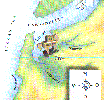
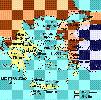 Now for Homer's history of Troy. In the Iliad, this is the town of ilium. The battle took place
in the 13th century BC, with Agamemnon, Achilles, Odysseus (Ulysses), Patroclus and Nestor on
the Achasan (Greek) side, and Priam with his sons Hector and Paris on the Trojan side. Homer
alludes to no commercial rivalries as cause for the war. Rather, he says that Paris kidnapped
the beautiful Helen from her husband Menelaus, King of Sparta, and the king asked the Achaeans
to help him get her back.
The war went on for a decade, during which Hector killed Patroclus and Achilles killed Hector.
When the time came for Paris to kill Achilles, he was upto the task. Paris knew that Achilles'
mother bad dipped her son in the Biver Styx, holding him by his heel, and had thus protected
Achilles from wounds anywhere that the water had touched. So Paris shot Achilles in the heel.
Even this carnage didn't end the war, so Odysseus came up with the idea of the wooden horse
filled with soldiers. That's the way Homer reported it. One theory has it that the earthquake
of 1275 BC gavethe Achaeans the break they needed, bringing down Troy's formidable walls and
allowing them to battle their way into the city. In gratitude to Poseidon, the Earth-Shaker,
they built a monumental wooden statue of his horse. Thus there may well have been a real Trojan
horse, even though Homer's account is less than fully historical. The last people to live here
were Turkish soldiers and their families, subjects of the Emir of Karasi, in the 1300s. After them,
the town disappeared until Schliemann arrived.
Now for Homer's history of Troy. In the Iliad, this is the town of ilium. The battle took place
in the 13th century BC, with Agamemnon, Achilles, Odysseus (Ulysses), Patroclus and Nestor on
the Achasan (Greek) side, and Priam with his sons Hector and Paris on the Trojan side. Homer
alludes to no commercial rivalries as cause for the war. Rather, he says that Paris kidnapped
the beautiful Helen from her husband Menelaus, King of Sparta, and the king asked the Achaeans
to help him get her back.
The war went on for a decade, during which Hector killed Patroclus and Achilles killed Hector.
When the time came for Paris to kill Achilles, he was upto the task. Paris knew that Achilles'
mother bad dipped her son in the Biver Styx, holding him by his heel, and had thus protected
Achilles from wounds anywhere that the water had touched. So Paris shot Achilles in the heel.
Even this carnage didn't end the war, so Odysseus came up with the idea of the wooden horse
filled with soldiers. That's the way Homer reported it. One theory has it that the earthquake
of 1275 BC gavethe Achaeans the break they needed, bringing down Troy's formidable walls and
allowing them to battle their way into the city. In gratitude to Poseidon, the Earth-Shaker,
they built a monumental wooden statue of his horse. Thus there may well have been a real Trojan
horse, even though Homer's account is less than fully historical. The last people to live here
were Turkish soldiers and their families, subjects of the Emir of Karasi, in the 1300s. After them,
the town disappeared until Schliemann arrived.


 Mythological Story...
The name Troy refers both to the remains of a Bronze Age fortress and city at Hisarlik, near the entrance to the
Dardanelles and to the legendary city of King Priam that was destroyed by the Achaeans in the Trojan War. There are
reasons to believe that the physical remains in Troy today correspond to the city in mythology. Troy was also once
known as Ilios or Ilion; this is reflected in the name of Homer's epic poem the Iliad, a work that claims to relate
the story of Troy's fall. According to sources in mythology the King of Troy was Priam and his wife was Hecuba. As a
result of the gods and goddesses' plot against Troy, Hecuba dreamed of fire coming out of her stomach and of smoke
covering the city walls. A soothsayer interpreted that the queen was pregnant and that the child would bring problems
to the city. The interpretation found acceptance and, in order to avoid problems, the baby was left in the forest
on Mount Ida where he would be looked after by a shepherd. The baby's name was Paris.
Many years later, Thetis, a sea goddess attended by the Nereids and beloved by both Zeus and Poseidon, married King
Peleus. Eris, the goddess of discord and sister of Ares, was not invited to the wedding. She became angry and tossed an
apple marked "for the fairest" among the gods causing trouble as they did not know to whom the apple was to be
given. Three women were nominated: Athena, Aphrodite and Hera. They consulted Zeus but he recommended them the judgment
of Paris who lived on Mount Ida. Each nominee promised something to Paris in order to get the apple. Athena promised
victory, Hera, kingship of the world, and Aphrodite, the most beautiful woman. Eventually Paris gave the apple to Aphrodite.
Mythological Story...
The name Troy refers both to the remains of a Bronze Age fortress and city at Hisarlik, near the entrance to the
Dardanelles and to the legendary city of King Priam that was destroyed by the Achaeans in the Trojan War. There are
reasons to believe that the physical remains in Troy today correspond to the city in mythology. Troy was also once
known as Ilios or Ilion; this is reflected in the name of Homer's epic poem the Iliad, a work that claims to relate
the story of Troy's fall. According to sources in mythology the King of Troy was Priam and his wife was Hecuba. As a
result of the gods and goddesses' plot against Troy, Hecuba dreamed of fire coming out of her stomach and of smoke
covering the city walls. A soothsayer interpreted that the queen was pregnant and that the child would bring problems
to the city. The interpretation found acceptance and, in order to avoid problems, the baby was left in the forest
on Mount Ida where he would be looked after by a shepherd. The baby's name was Paris.
Many years later, Thetis, a sea goddess attended by the Nereids and beloved by both Zeus and Poseidon, married King
Peleus. Eris, the goddess of discord and sister of Ares, was not invited to the wedding. She became angry and tossed an
apple marked "for the fairest" among the gods causing trouble as they did not know to whom the apple was to be
given. Three women were nominated: Athena, Aphrodite and Hera. They consulted Zeus but he recommended them the judgment
of Paris who lived on Mount Ida. Each nominee promised something to Paris in order to get the apple. Athena promised
victory, Hera, kingship of the world, and Aphrodite, the most beautiful woman. Eventually Paris gave the apple to Aphrodite.
 Aphrodite's most beautiful woman was Helen who was married to Menelaus, King of Sparta. Paris fell in love with Helen and
abducted her to Troy. This was the reason for the ten-year Trojan War between the Trojans and the Achaeans from the
mythological point of view. Agamemnon was the commander in chief of the Achaeans in the Trojan War. He was the King of
Mycenae and a brother of Menelaus. Before coming to Troy, Agamemnon agreed to sacrifice his daughter Iphigenia in order
to ensure a fair wind for his ships.
According to Iliad, in the tenth year of the Trojan War, Achilles withdrew from the fighting after Agamemnon seized his
favorite slave girl. He sulked in his tent until the death of his close friend Patroclus stirred him to return to battle.
The smith-god Hephaestus forged him a fine set of arms, including a famous shield on which was depicted the whole range
of the human condition. Thus equipped, he avenged Patroclus's death in a celebrated duel with the great Trojan hero Hector.
After dragging Hector's body seven times around the walls of Troy behind his chariot, Achilles was persuaded to allow the
slain Trojan hero a proper funeral. Later Paris killed Achilles. When the Achaeans understood that they would not be able
to capture the city by war, they decided to prepare a trick. The Achaean fleet sailed out of sight, leaving the Trojan
Horse behind as a "gift". Inside the large wooden horse was concealed a squad of soldiers who, after the horse
had been dragged into the unsuspecting city and under the cover of darkness, emerged and opened the gates. After the
fleet quietly returned, the soldiers entered Troy and great slaughter followed. Many Trojan women, including members of
the royal family, were carried off into captivity.
Aphrodite's most beautiful woman was Helen who was married to Menelaus, King of Sparta. Paris fell in love with Helen and
abducted her to Troy. This was the reason for the ten-year Trojan War between the Trojans and the Achaeans from the
mythological point of view. Agamemnon was the commander in chief of the Achaeans in the Trojan War. He was the King of
Mycenae and a brother of Menelaus. Before coming to Troy, Agamemnon agreed to sacrifice his daughter Iphigenia in order
to ensure a fair wind for his ships.
According to Iliad, in the tenth year of the Trojan War, Achilles withdrew from the fighting after Agamemnon seized his
favorite slave girl. He sulked in his tent until the death of his close friend Patroclus stirred him to return to battle.
The smith-god Hephaestus forged him a fine set of arms, including a famous shield on which was depicted the whole range
of the human condition. Thus equipped, he avenged Patroclus's death in a celebrated duel with the great Trojan hero Hector.
After dragging Hector's body seven times around the walls of Troy behind his chariot, Achilles was persuaded to allow the
slain Trojan hero a proper funeral. Later Paris killed Achilles. When the Achaeans understood that they would not be able
to capture the city by war, they decided to prepare a trick. The Achaean fleet sailed out of sight, leaving the Trojan
Horse behind as a "gift". Inside the large wooden horse was concealed a squad of soldiers who, after the horse
had been dragged into the unsuspecting city and under the cover of darkness, emerged and opened the gates. After the
fleet quietly returned, the soldiers entered Troy and great slaughter followed. Many Trojan women, including members of
the royal family, were carried off into captivity.
 Archeological Evidence...
Troy was rediscovered and excavated by Heinrich Schliemann (1870-90). Many excavations have been carried out by different
archeologists from different countries. From the evidence recovered by archeologists, there had been settlement in Troy
from 3000 BC until 400 AD in nine different layers, each established on the previous layer.
Troy I (3000-2500 BC) : The earliest settlement was a small fortress enclosed by a strong wall. Houses were built
with foundations of stone and walls of clay brick. The settlers knew of copper but normally used bone and stone for tools
and weapons. Most of their surviving possessions were of earthenware pottery. Troy I, like many other ancient settlements,
came to its end in a devastating fire.
Archeological Evidence...
Troy was rediscovered and excavated by Heinrich Schliemann (1870-90). Many excavations have been carried out by different
archeologists from different countries. From the evidence recovered by archeologists, there had been settlement in Troy
from 3000 BC until 400 AD in nine different layers, each established on the previous layer.
Troy I (3000-2500 BC) : The earliest settlement was a small fortress enclosed by a strong wall. Houses were built
with foundations of stone and walls of clay brick. The settlers knew of copper but normally used bone and stone for tools
and weapons. Most of their surviving possessions were of earthenware pottery. Troy I, like many other ancient settlements,
came to its end in a devastating fire.
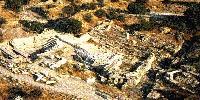

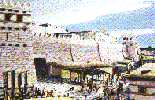 Troy II (2500-2200 BC) : Although only 122 m / 400 ft across, was slightly larger than the preceding settlement
and had more massive walls and larger buildings. It was one of the earliest cities in Anatolia to show evidence of town
planning. It was wealthier than Troy I; it possessed more gold and silver and made much more use of copper. Its artisans
were more advanced; the potter's wheel, for example, appeared at Troy during phase II, when the Trojans were in contact
with both the Aegean world to the west and central Anatolia to the east. Troy's power and wealth were probably derived
from its strategic position, controlling important trade routes between Asia and Europe. The ruler, his family and their
most trusted retainers probably lived in the fortress, whereas the majority of the Trojan people lived in the surrounding
countryside, grew grain and other crops, tended livestock and provided troops when required. Troy II, like Troy I, suffered
catastrophic devastation by fire.
Troy III, IV, V (2200-1800 BC) : Although the character of the fortress was preserved throughout these three
periods, this era was undistinguished and of minor importance.
Troy VI (1800-1275 BC) : A city established by newcomers with well-constructed walls. This phase was the high point
of Troy's history. The area enclosed by the citadel was then about 230 m / 750 ft across, with finely crafted stone walls
and stoutly fortified gates. Once again, the rulers of Troy occupied a position of power and importance in relation to the
neighboring Aegean and Anatolian peoples. It was destroyed by earthquake.
Troy VIIa (1275-1240 BC) : Resettled by the survivors of Troy VI, depended on the same fortifications. Its houses
were crowded together; many had large storage jars sunk beneath the floors. Sewage system pipes dating from this period
can be seen in the main street that goes to the southern gate. Just to give an idea to compare with Athens, at that time
there was no Athens and even in the golden years of Athens (4-3C BC) there was no sewage system. The impression is that of
a community under stress, possibly like Priam's citadel, the siege of which features in the Iliad and other stories of the
Trojan War. According to tradition, Troy fell in 1184 BC. The archaeological evidence supports a date of about 1200 BC for
the destruction of Troy VIIa.
Troy II (2500-2200 BC) : Although only 122 m / 400 ft across, was slightly larger than the preceding settlement
and had more massive walls and larger buildings. It was one of the earliest cities in Anatolia to show evidence of town
planning. It was wealthier than Troy I; it possessed more gold and silver and made much more use of copper. Its artisans
were more advanced; the potter's wheel, for example, appeared at Troy during phase II, when the Trojans were in contact
with both the Aegean world to the west and central Anatolia to the east. Troy's power and wealth were probably derived
from its strategic position, controlling important trade routes between Asia and Europe. The ruler, his family and their
most trusted retainers probably lived in the fortress, whereas the majority of the Trojan people lived in the surrounding
countryside, grew grain and other crops, tended livestock and provided troops when required. Troy II, like Troy I, suffered
catastrophic devastation by fire.
Troy III, IV, V (2200-1800 BC) : Although the character of the fortress was preserved throughout these three
periods, this era was undistinguished and of minor importance.
Troy VI (1800-1275 BC) : A city established by newcomers with well-constructed walls. This phase was the high point
of Troy's history. The area enclosed by the citadel was then about 230 m / 750 ft across, with finely crafted stone walls
and stoutly fortified gates. Once again, the rulers of Troy occupied a position of power and importance in relation to the
neighboring Aegean and Anatolian peoples. It was destroyed by earthquake.
Troy VIIa (1275-1240 BC) : Resettled by the survivors of Troy VI, depended on the same fortifications. Its houses
were crowded together; many had large storage jars sunk beneath the floors. Sewage system pipes dating from this period
can be seen in the main street that goes to the southern gate. Just to give an idea to compare with Athens, at that time
there was no Athens and even in the golden years of Athens (4-3C BC) there was no sewage system. The impression is that of
a community under stress, possibly like Priam's citadel, the siege of which features in the Iliad and other stories of the
Trojan War. According to tradition, Troy fell in 1184 BC. The archaeological evidence supports a date of about 1200 BC for
the destruction of Troy VIIa.
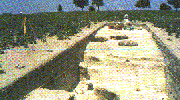
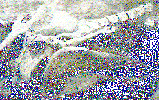
 Troy VIIb (1200-1100 BC) : Resettlement followed on a small scale.
Troy VIII (700-350 BC) : Troy in this period appeared to be a small market town.
Troy IX (350 BC-400 AD) : During this phase Troy was a Hellenistic and Roman city.
Heinrich Schliemann...
A pioneer in field archaeology, the German archaeologist Heinrich Schliemann is best known for his excavations at ancient
Troy and Mycenae. Schliemann was largely self-educated. Because his family was poor, he had to leave school at the age of
14 to earn a living. He continued studying on his own, however, showing an exceptional ability in mastering foreign
languages. He soon began to exploit his remarkable aptitude for business dealings, which enabled him to amass a large
fortune early in life and to retire at the age of 41. From then on, he devoted himself to archaeology. He began to dig
at Troy, his most famous excavation, in 1870. Schliemann has been criticized for using methods that seem crude by
comparison with the techniques of today. He also has been criticized for being a treasure hunter rather than an
archeologist. The moment he found the so-called treasures of King Priam, he left the excavation with the treasures.
According to some he deserves great credit, however, for creating methods where none had existed previously and for
demonstrating that excavation can be more than a mere treasure hunt that it can, in fact, restore a knowledge of lost
civilizations.
Troy VIIb (1200-1100 BC) : Resettlement followed on a small scale.
Troy VIII (700-350 BC) : Troy in this period appeared to be a small market town.
Troy IX (350 BC-400 AD) : During this phase Troy was a Hellenistic and Roman city.
Heinrich Schliemann...
A pioneer in field archaeology, the German archaeologist Heinrich Schliemann is best known for his excavations at ancient
Troy and Mycenae. Schliemann was largely self-educated. Because his family was poor, he had to leave school at the age of
14 to earn a living. He continued studying on his own, however, showing an exceptional ability in mastering foreign
languages. He soon began to exploit his remarkable aptitude for business dealings, which enabled him to amass a large
fortune early in life and to retire at the age of 41. From then on, he devoted himself to archaeology. He began to dig
at Troy, his most famous excavation, in 1870. Schliemann has been criticized for using methods that seem crude by
comparison with the techniques of today. He also has been criticized for being a treasure hunter rather than an
archeologist. The moment he found the so-called treasures of King Priam, he left the excavation with the treasures.
According to some he deserves great credit, however, for creating methods where none had existed previously and for
demonstrating that excavation can be more than a mere treasure hunt that it can, in fact, restore a knowledge of lost
civilizations.


























